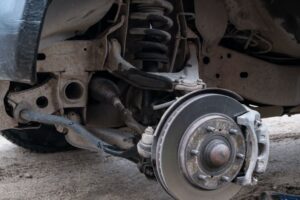Seeing white smoke from the exhaust might not be anything serious. But you should know what causes it, whether it is when you are idle, accelerating, or starting up your car or truck. What causes white smoke to come from the exhaust?
White smoke from your exhaust pipe when you start your car could be caused by an engine that is consuming coolant. A leaking head gasket commonly causes the coolant to be burned in the engine.
If there is white smoke coming from the exhaust when your car is idle, that could mean there is a cracked intake gasket.
Read on to learn more about white smoke from the exhaust, its causes, and how to fix it.
White Smoke from Exhaust [When Starting, Idle, or Accelerating]
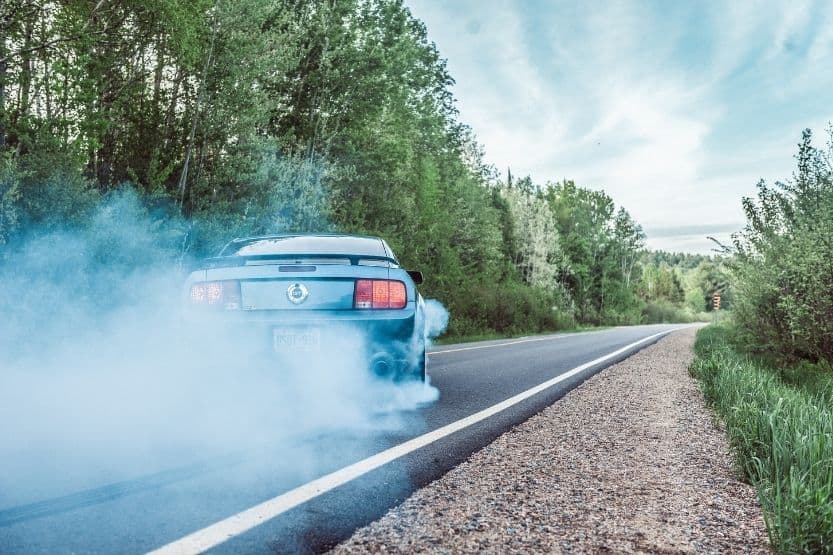
Usually, white smoke coming from the exhaust means there is condensation in the exhaust pipe. A more serious issue could be an engine coolant leak.
There’s a reason why you observe white smoke when your car starts when it is idle and when it is accelerating.
White Smoke from Exhaust on Startup
If you see white smoke coming out of the exhaust when you start the engine, don’t panic just yet. Observe the smoke if it disappears after a couple of minutes. If it does, it’s most likely just water in the tailpipe turning into steam from the engine’s heat.
White smoke from the exhaust on startup usually happens in cold places. Specifically where there is a lot of dew in the mornings. If that is the case, the white smoke will go away once all the dew dries up.
Another reason for the white smoke could be a coolant leak. This may happen if there is a crack or puncture in the coolant reservoir, and the coolant could spill onto the engine block and get mixed with the fuel.
White smoke when you start up the car could also be the result of a faulty fuel injector. This refers to the part of the car’s engine that shoots fuel into the combustion chamber.
If it does not get the timing just right, the chamber will flood with fuel, resulting in a rough start and a lot of smoke coming out of the tailpipe.
The white smoke should be gone after a couple of minutes. If the smoke is still there after five minutes, then there might be other causes, and you have to find out exactly what it is to know how to deal with it.
White Smoke from Exhaust When Idle
If the smoke persists after a couple of minutes have passed since you started the engine, there might be some slight issues that you need to get resolved.
One reason why there is white smoke coming from the exhaust when idle is a cracked intake gasket. The intake manifold is responsible for delivering air into the engine block.
If there is a crack on the gasket between the manifold and the engine block, engine oil might find its way into the combustion chamber.
When the engine burns fuel and oil, it produces greyish-white smoke. If the problem worsens, then the smoke becomes pitch black. Another symptom that you might experience when you have a cracked manifold gasket is the loss of power. It will feel like your car does not accelerate like it used to.
Another probable reason for the white smoke while idling is a faulty Electronic Control Unit (ECU). This refers to the computer that controls the engine of the car.
If you have a faulty ECU, it might cause the fuel injectors to run out of sync with the engine’s pistons, thereby flooding the engine with too much or too little fuel. It can cause the engine to belch white smoke while also triggering the cylinders to misfire.
White Smoke from the Exhaust When Accelerating
One possible reason why there is white smoke from the exhaust when accelerating is a cracked or blown head gasket. The head gasket is placed in between the engine block and the cylinder head. It prevents oil and coolant from getting into the combustion chamber.
If there’s considerable damage to the head gasket, the oil and coolant can get sucked into the combustion chamber every time you step on the gas; thus, producing the white smoke. If the damage gets worse, the smoke will turn black.
White smoke could also be a result of a faulty ECU. As mentioned earlier, the ECU might not be sending the right instructions to the fuel injectors, causing them to flood the combustion chambers with too much fuel, and the excess is turned into emissions.
Probably the most serious problem that could cause white smoke is a cracked engine block. This is serious because not only does this result in a lot of engine oil getting into the cylinders, but this can also cause a loss in compression.
In other words, your car will not have the same amount of power that it used to have.
Problems That Could Arise If the White Smoke Issue Is Not Resolved
Many mechanical issues may develop because of the white smoke in your exhaust, which is why you need to address the problem as soon as you can. If your car’s ECU is malfunctioning, white smoke is only the least of your problems.
A faulty ECU can cause the engine to misfire, causing the engine to stall while idling in the middle of traffic. This can also result in your car suddenly losing acceleration while you are driving on the highway.
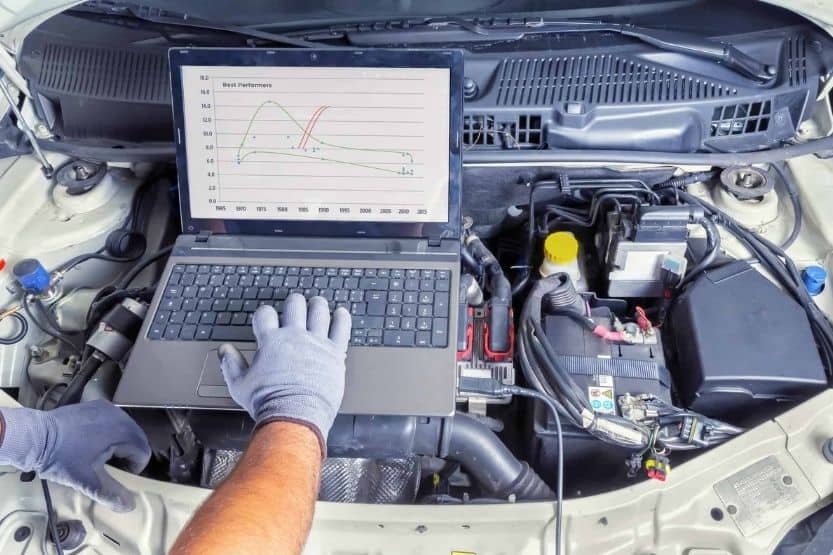
Blown head and intake manifold gaskets can cause more damage as burnt oil in the combustion chambers will cause sludge to form. It can prevent the pistons from traveling up and down efficiently. Also, if left unattended, it can damage the pistons, resulting in costly repairs.
If enough engine oil is wasted, it can trigger the engine to overheat as there will not be enough lubrication for the moving parts. Speaking of the engine overheating, the same could be if there is a crack or hole in the coolant reservoir.
Aside from producing a lot of white smoke, not enough coolant in the car’s radiator and cooling system will cause the engine to overheat and seize.
The most serious problem could be a cracked engine block. If the crack gets bigger, it can lead to the engine completely shutting off and not working again. The worst-case scenario is that it can cause the entire engine bay to go up in flames.
How to Prevent White Smoke from the Exhaust?
Seeing white smoke in your exhaust is usually not a good sign, so you need to find and fix the causes before things get worse.
You can inspect the following before having your car serviced in your local garage:
1. Use Duct Tape
If you found a crack or hole in the coolant reservoir, you can patch it up temporarily using duct tape. However, you should replace the entire reservoir as soon as you can. It is more cost-effective to do so compared to trying to find a permanent fix.
2. Use an Automotive Diagnostic Tool or Scanner
It is also a good idea to get yourself an automotive diagnostic tool or scanner. This is an electronic device that you connect to the OBD (onboard-diagnostic) port in your car. It can tell you if there is anything wrong with it. This tool will help you to at least confirm if there is a problem with the ECU.
It is a handy tool to have if you like tinkering with your car. You can use it to determine whether you need help in fixing your car too.
You can use the diagnostic tool to confirm a fuel injection system problem, like if the fuel-air mixture is too rich. To check if there is a crack in any of the gaskets, do the following:
- Clean your engine as best as you can, or at least the intake manifold and the sides of the engine block;
- Drive your car around for around fifteen minutes; and
- Check if there are any oil traces in the places you cleaned earlier.
If there are, then it is highly likely that there are cracks in the gaskets.
Fixing White Smoke Issues
Once you have determined that there are problems with your car, you can try to fix them yourself if you have the right tools and you are confident working with your hands.
Here are some areas to focus on:
1. “Fixing” the ECU
If the ECU is causing the cylinders to misfire or making the fuel-air mixture too rich, you will not be able to reprogram it unless you are a professional technician. You have all the necessary tools to do it, which is doubtful. The best that you can do is replace it with a brand new one.
2. Replacing the Worn-out Gaskets
If the reason for your car spewing out white smoke is a blown gasket, there are a couple of ways for you to confirm the diagnosis:
- Clean the junction where the gasket is located. In this case, you need to clean the intake manifold and the cylinder head;
- After cleaning the engine, drive your car around for about fifteen minutes; and
- Afterward, check the places that you previously cleaned. If there are traces of engine oil or coolant, then the gaskets are definitely blown.
You can replace the gaskets on your own if you have the right tools, in this case, a torque wrench and the right replacement gaskets. You can buy the gaskets from your local automotive parts store or online. Just make sure that you get the right gasket for your car’s make and model.
Carefully remove all the bolts that attach the manifold/cylinder head to the engine block. It is best to label the bolts so that you know the order to put them back later. Carefully pry the manifold/cylinder head away to expose the gasket.
Usually, you can peel off the old gasket in one piece, but you may need something like a putty knife to scrape it off the surface if it is too worn out. Be careful not to get any debris inside the engine.
Carefully place the new gasket, then replace the manifold/cylinder head. Put the bolts back in the right order and gradually tighten each one to the right torque. It is important to follow the correct torque sequence and do it gradually so you do not warp the parts.
3. Fixing a Cracked Engine Block
Unfortunately, unless you have an A-frame and a chain block, you will not be able to fix a cracked engine block on your own. To do this properly, you will need to remove the entire engine from the rest of the car, so it is best to have this done in a professional garage.
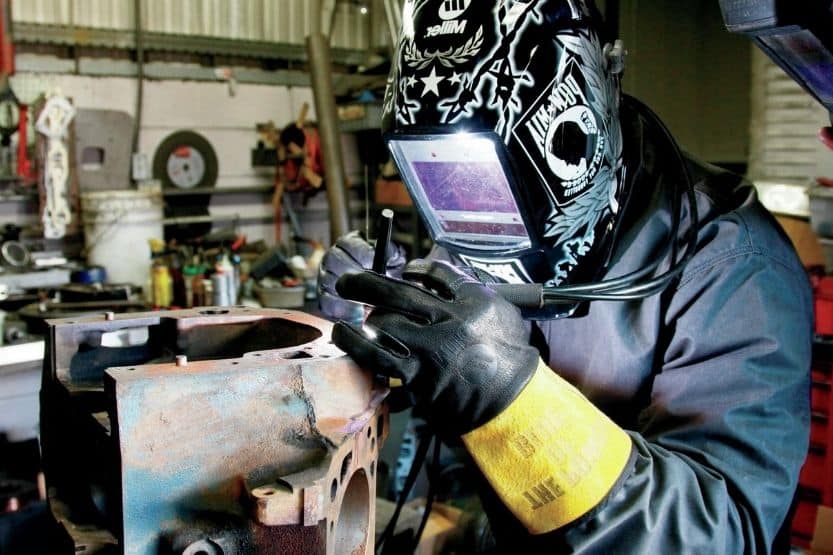
About Vehicle Emissions
Your car’s exhaust system takes care of the harmful fumes produced when the engine burns fuel. The exhaust system redirects the engine’s toxic fumes away from the driver and passengers and releases them behind the vehicle.
It is also a huge help in reducing the toxicity of the exhaust gases by forcing them through a catalytic converter. It can greatly reduce the harmfulness of the smoke, thus keeping the air clean.
Normally, you should not see any smoke coming out of the tailpipe because this means that the engine is efficiently burning the fuel. However, seeing a bit of smoke is not necessarily a cause for alarm. Note that it usually happens as the car gets older.
Seeing white smoke coming out of your vehicle’s exhaust is more alarming than seeing black smoke. Regardless of the color of your car’s emissions, you will need to have it checked by a professional mechanic.
But you should still know why there is white smoke from the exhaust in the first place to prevent the garage from overcharging you.
Conclusion – White Smoke Coming From Exhaust [Accelerating, Startup, or Idle]
White smoke coming from the exhaust pipe could be caused by an engine that’s consuming coolant. A leaking head gasket normally causes the coolant to be burned in the engine.
White smoke coming from the exhaust pipe when your car is idle could mean a cracked intake gasket.
The tricky thing about white smoke from the exhaust is that it could be nothing, but it can also be a sign that there is something seriously wrong with your car’s engine.
It is important to know why your car is belching out white smoke so you can fix the issue before it gets so much worse.
Related reading:
Smoke Test for Car – How to Test and Cost
Magnaflow Vs Flowmaster Exhaust System [Which Is Better?]

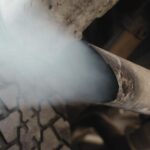
![White Smoke On Startup Then Disappears [Causes and Solutions] White smoke On Startup Then Disappears](https://roadsumo.com/wp-content/uploads/2021/11/white-smoke-on-startup-then-disappears-150x150.jpg)


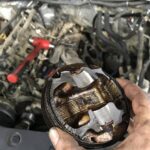

![Read more about the article Maaco Review [Is It Good? Why Is It Cheap?]](https://roadsumo.com/wp-content/uploads/2022/04/Maaco-review-300x200.jpg)

